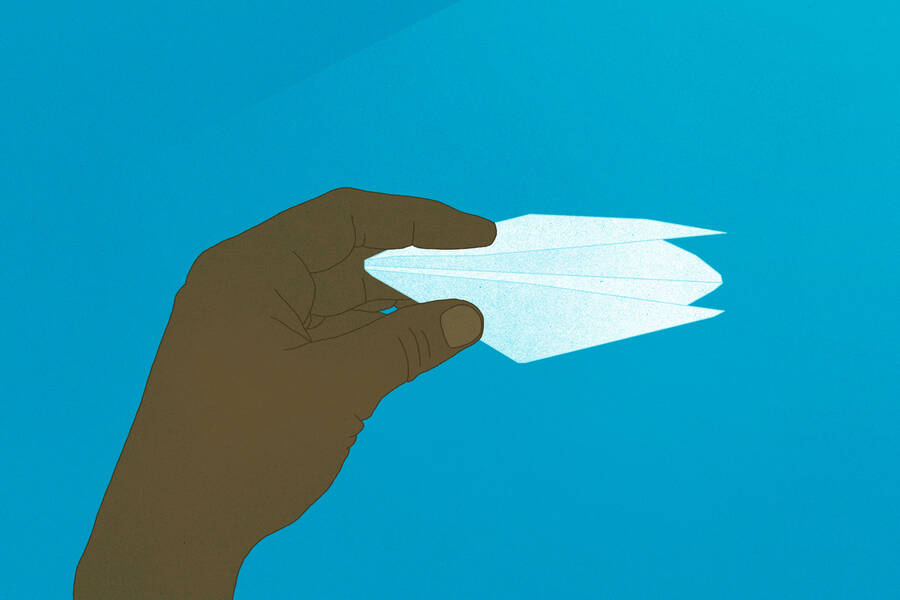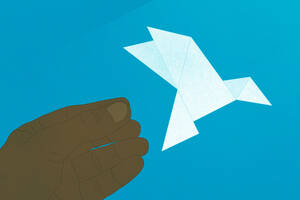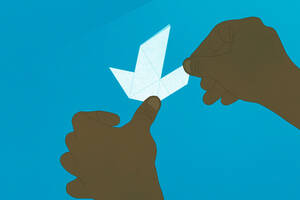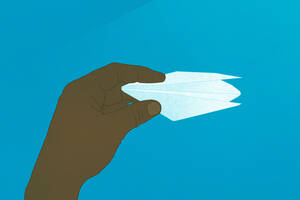Marketing Entrepreneurship Aug 29, 2022
Podcast: What Should Your Brand Look (and Sound and Smell) Like?
In episode 3 of our 5-episode series, “Insight Unpacked: Extraordinary Brands and How to Build Them,” we discuss the associations you want customers to make with your brand, and how to use design to make it happen.

Lisa Röper
Channel your inner artist because it’s design time. But it’s not enough to create something “nice.” You’ll need to determine what reaction you want your brand to evoke in people—and then use design to make that happen.
On this episode, Kellogg professor Bobby Calder looks at how great brands define themselves, how stale brands revitalize themselves, and why you should use all your senses when creating a brand image. We discuss clever multimedia campaigns and explore how soundmarks and audio branding can open the door to new brand associations.
Supplementary Materials
Prof. Bobby Calder highlights Coca-Cola as a brand that has used design to evoke specific associations with customers. To watch how the brand (and its design) has evolved over time, we recommend this slideshow.
*
This creative ad campaign—which involved giving away Danish flags fashioned from the Coca-Cola logo at a Danish airport—is a favorite of Calder’s.
*
The Kellogg Insight team’s own branding journey led us to build this mood board.

*
Here are some logos we considered in the process of creating our origami bird for Insight Unpacked.
We started with a text-only version, using the encircled R to evoke a registered trademark symbol. This felt a bit flat for us.

So we tried a version that brought the two-layered circle from our other podcast, The Insightful Leader, into play. It was progress, but we found the BRANDS text too busy.
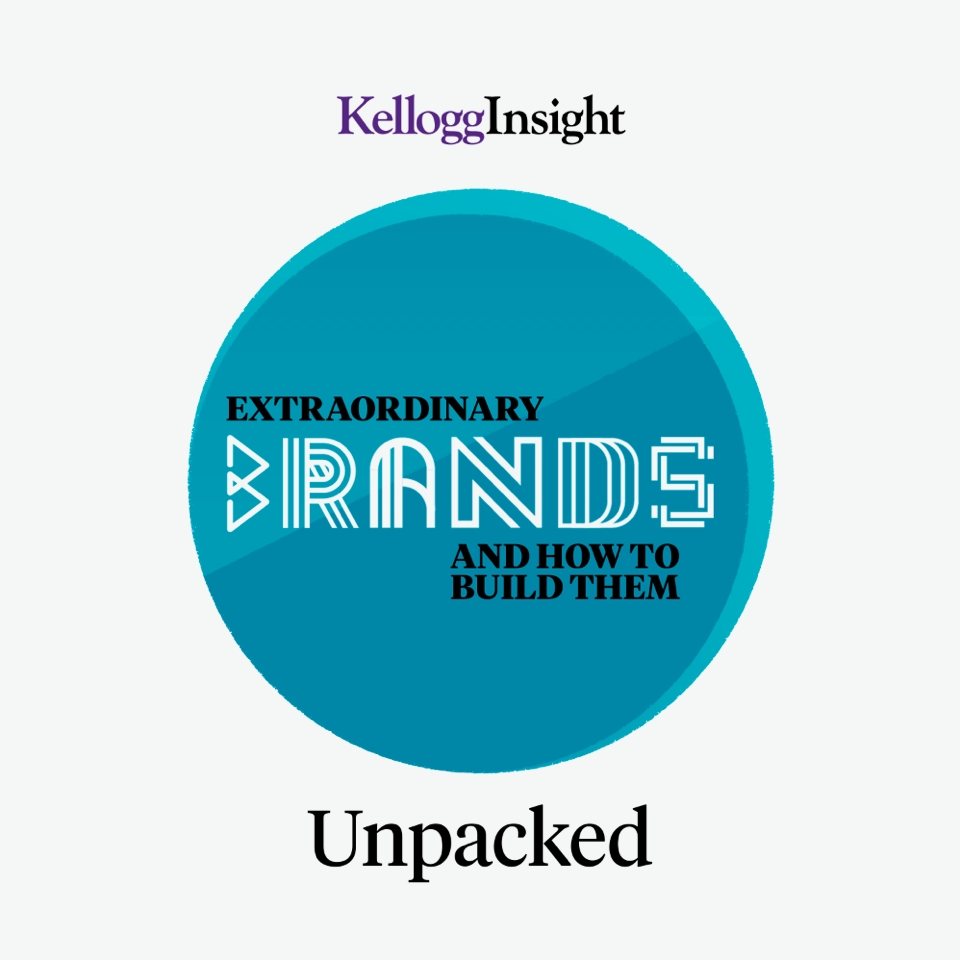
We then attempted a “fingerprint” design, to evoke the individuality of unique brands. We did this in both white and black versions.
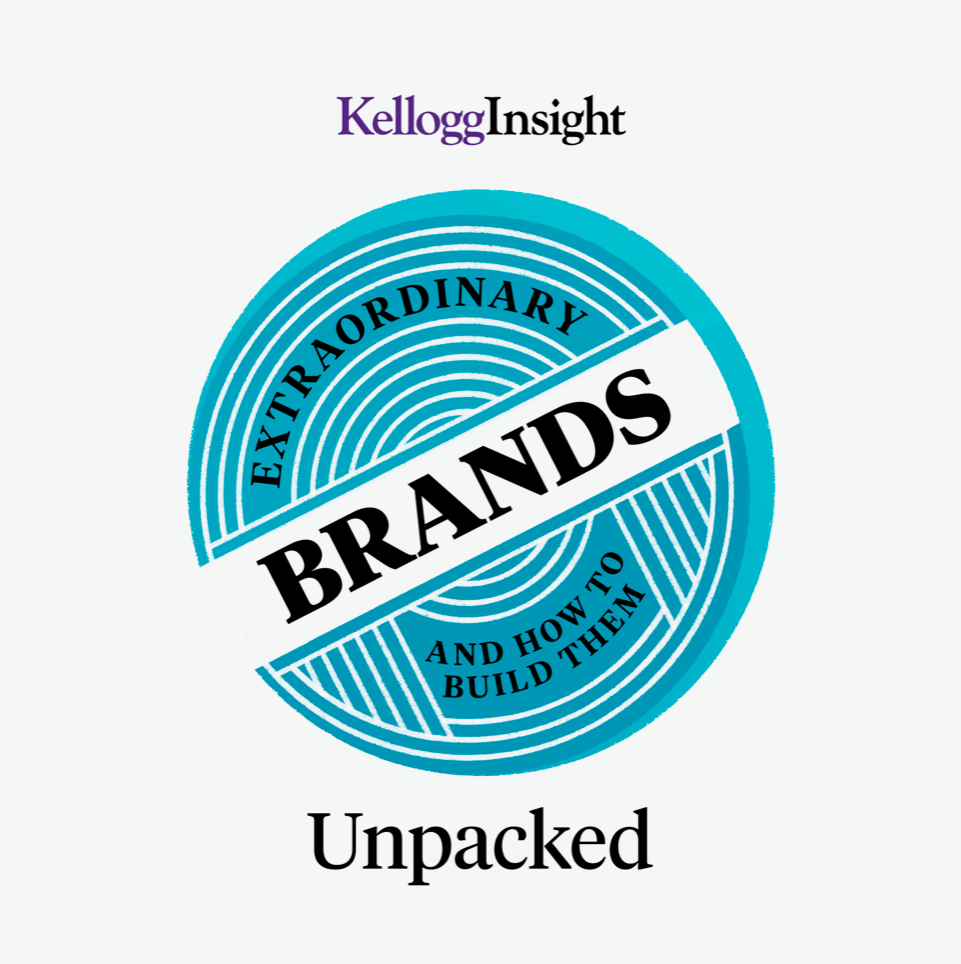
We passed on this version when we realized that rather than evoking a fingerprint, it looked more like the burner on an electric stove.
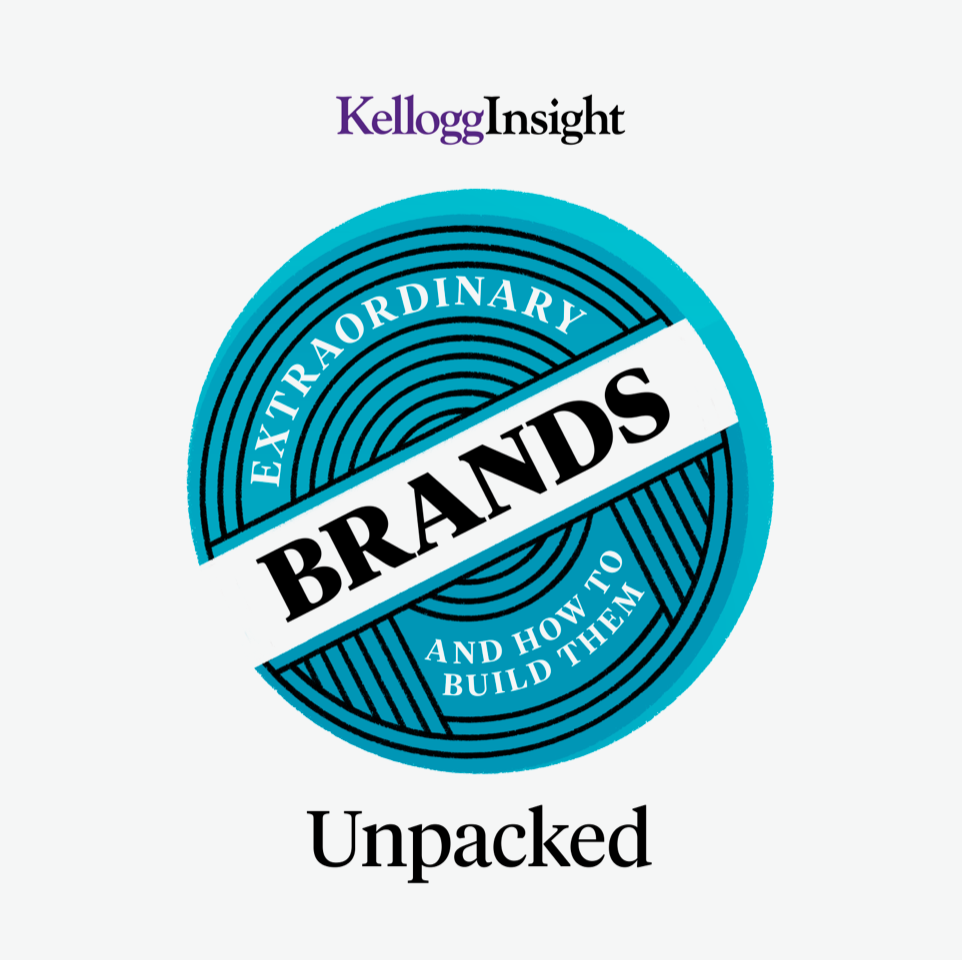
So we tried simplifying again, but this, like the original text treatment, left us wanting something more extraordinary.
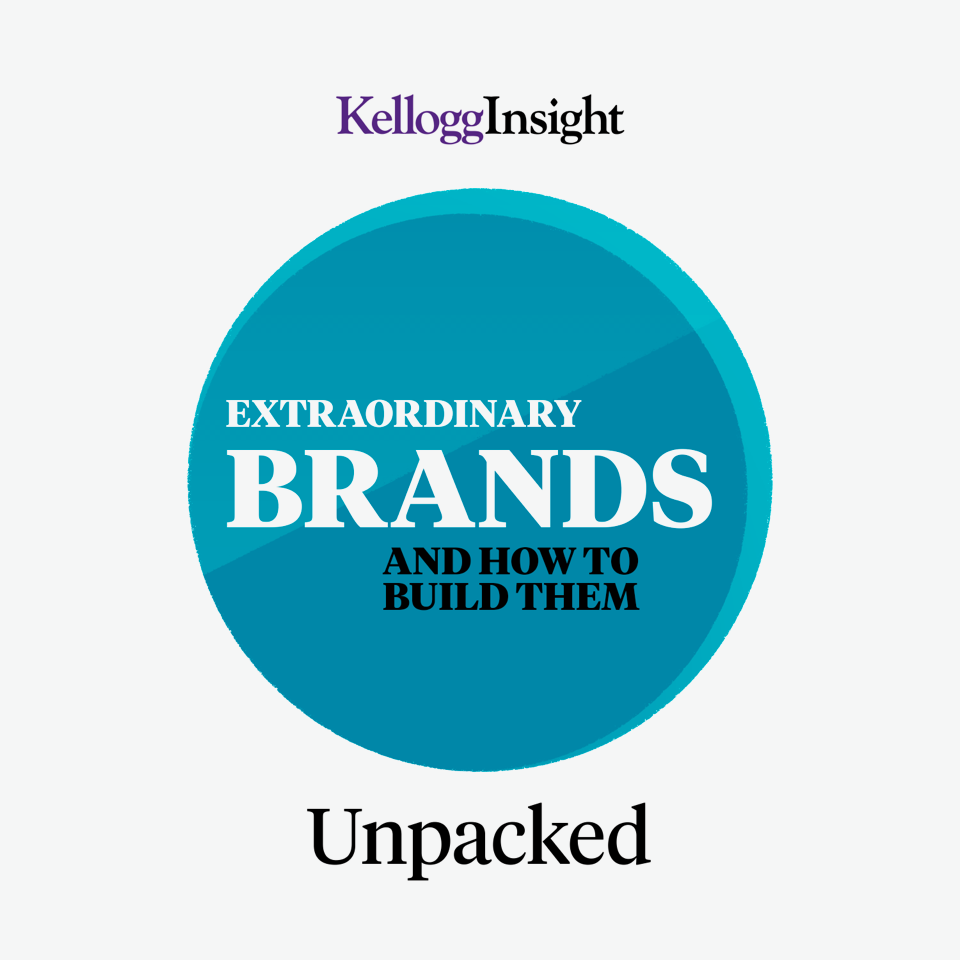
It was then that our designers came up with the process-oriented, step-by-step illustration for folding an origami paper crane. We liked the poetics of the image, and made a few recommendations to simplify the image for the podcast tile format.
*
And these are some of the potential soundmarks we created. What associations do they evoke for you?
*
For more on soundmarks, and audio branding more generally, check out this podcast episode, which explores how brands are increasingly defining their sound.
For more information on brand associations, James Conley, a clinical professor of operations at Kellogg, recommends these academic articles published by Kellogg faculty:
“Using Brand Identity to Reinforce Market Value” in INNOVATION, Industrial Design Society of America quarterly Journal Winter 2005.
“Inventing Brands: Opportunities at the Nexus of Semiotics and Intellectual Property” in Design Management Review, Spring 2008, Vol 19 No. 2.
“Value Articulation: A Framework for the Strategic Management of Intellectual Property” in California Management Review, Summer 2013, Vol. 55 No. 4.
The first season of Insight Unpacked primarily features Kellogg faculty contributors to the book Kellogg on Branding in a Hyperconnected World. This book is available for purchase here. In addition, you can read three free excerpts on Kellogg Insight.
Prof. Paul Earle Jr.’s chapter on finding the right name for your brand.
Prof. Bobby Calder’s chapter on using design thinking to find a design that appeals to consumers on an unconscious level.
Prof. Mohan Sawhney on transmedia storytelling for brands.
Podcast Transcript
Jessica LOVE: Hey there listeners! The episode you’re about to hear is number THREE of a five-part mini-series. So again, if you haven’t already, we encourage you to listen to the FIRST TWO episodes before you dig into this one. You can find them right in our podcast feed…or, you can search for Insight: UNPACKED wherever you get your podcasts. Thanks!
-----------------
LOVE: We as humans tend to think that we’re aware of what happens in our brains. We imagine ourselves intentionally processing information… drawing careful, logical connections… and coming to thoughtful, deliberate conclusions. And it’s true… our brains DO do all of those things. But…that’s not all they do.
Bobby CALDER: But the human brain is of course designed to do much more than that.
LOVE: That’s Bobby Calder, an emeritus professor of marketing at Kellogg. Calder is a scholar of consumer psychology. And as he explains, our brains essentially have two systems running all the time. There’s the rational, deliberate, self-aware system, the one that reasons through things calmly and carefully. But running in the background, there’s also another system… one that’s much more automatic… more instinctive.
CALDER: People are not really thinking about thinking. Their mind is just processing what they’re taking in.
LOVE: This second system is the one that picks up on things like shapes, and colors, and smells. And this system… has served us well throughout human history. Because by taking in these TINY details in the blink of an eye, before our conscious brain even knows what’s happening, we were able to, for example, perceive threats, and respond very quickly.
CALDER: If, you know, you’re wandering through the jungle trying to figure out if that’s a lion out on the perimeter of your area, it’d be best to just react with a flight response and think about it later.
[JUNGLE SOUNDS]
LOVE: But in our modern hyperconnected world, that part of our brains is no longer just picking up on lions. These days, many of the tiny psychological cues we unconsciously absorb… are put there very intentionally by BRANDS that want to register in that part of our minds.
[MONTAGE: BRAND SOUNDMARKS]
LOVE: So for marketers, THIS is now where the competition is. Powerful brands… the ones that cut through the clutter… they don’t just appeal to that logical, self-conscious system. The best brands also operate in this deeper part of our minds. And they do that… through design… through the colors, the shapes, the images, the sounds, even the smells that are part of that brand. Which is why developing an effective brand design isn’t just about making something that looks “NICE”. It’s about figuring out the specific reactions you want to spark in people... and then finding a way to ignite those sparks.
CALDER: What you’re trying to do is think about cues that actually could work to your advantage. So it’s not an aesthetic judgment. It’s a judgment based on a consumer psychology of what’s going to give you the kind of thoughts you want in the consumer’s mind?
[THEME MUSIC]
LOVE: Welcome to Insight Unpacked, a podcast mini-series from Kellogg Insight at Northwestern University’s Kellogg School of Management. This is season one, Extraordinary Brands and How to Build Them. I’m your host, Jess Love.
On this, the third episode of our five-part series, we’re exploring brand DESIGN. And with design, comes a different approach branding…one that’s different from our previous episodes…because it means we have to look under the hood of the human mind…to see what attracts people to something…and then tap into those unconscious processes to really draw people in.
To do that, Bobby Calder will first guide us through what good brand design means, and the process for developing and testing your own designs. Then we’ll hear how cutting-edge brands are expanding what design means in the 21st century—by tapping into other human senses. Plus our team here at Kellogg Insight gets to work figuring out what our new podcast brand should look, feel, and sound like.
[MUSIC]
LOVE: So let’s say you want to develop a brand design of your own. There are FOUR steps you’ll want to take. You will first want to consider your brand position. You’ll next want to determine the kinds of associations you want to conjure in people’s minds…ones that tie back to your brand position. Third, you’ll want to engage in “design thinking” to develop a prototype design. And fourth, you will need to test that prototype to make sure it’s hitting the mark with people.
So let’s get into it.
How should you think about what good brand design even means? Before you start thinking about colors or logos, Bobby Calder, our expert for this episode, says there’s something much more fundamental that you have to do. And if you’ve been listening to this podcast… you probably know what’s coming. Here’s Calder again.
CALDER: The first step, as always, is to really articulate very clearly the brand positioning you’re after.
LOVE: Like just about everything else, design comes back to the brand position… the statement articulating how you want your brand to be perceived, who you’re targeting, and what sets you apart. If you remember, we talked a lot about brand positioning in the first episode. That’s what good brand design means…it’s something that effectively conveys your brand position. Putting this at the forefront of your mind before you start designing is the first step in our design journey.
That brings us to the second step: figure out what kinds of associations you want your design to instill in people’s minds. Obviously, you want those associations to be tied to your brand position.
So…how do you do that? Well, there’s a real science to it.
Let’s take the example of Coca-Cola. One part of Coke’s brand position is timelessness. They want to evoke the feeling that you’re partaking in a time-honored tradition. Calder says, one way they project that… is with their choice of font.
CALDER: They realized very early on that you could render that name in a Spenserian script that made it more of a signature, traditional kind of look and gave it some veritas, if you will.
LOVE: But at the same time, Coke’s design also evokes another brand value... the unique, the refreshing, the out-of-the-ordinary.
CALDER: The bottle has this unique shape that signifies both tradition and uniqueness, which is very hard to convey, right?
LOVE: Finally, Coke wants to evoke joy… the feeling that you’re taking time to enjoy a CELEBRATORY moment. Which, Calder says, is where COLOR comes in.
CALDER: The color red is sort of regal and above the ordinary, and so they use red at every chance they can get.
LOVE: As you can see, all of these decisions are PAINSTAKINGLY intentional. So how can YOUR brand follow suit? That is, once you know what associations to make, how do you come up with a DESIGN that will actually deliver them?
That brings us to step three of our design process…the part that involves getting your hands dirty…and it’s this: You have to think like a designer. This is called “design thinking.”
CALDER: What design thinking is, it’s not just turning it over to a packaging designer, which was largely the practice through most of the last century for a lot of companies. What design thinking adds to the picture is, let’s actually create and make different versions of the brand design, and evaluate whether they’re actually delivering the associations that you intend.
LOVE: Now, for some people, this may sound a little scary. You may be thinking, “I’m no designer!” Calder gets that a lot. Over and over again, he’s seen people, even confident executives, freeze up when they’re asked to draw a simple picture of a logo or package design they’re imagining. But, he emphasizes, being actively involved in the design process can pay real dividends for a brand. It forces you to articulate what your brand is about... not just using words, but in visual and tactile ways. And it can bring out your creativity. Because whether you’re a marketer or a CEO, you get to think like an artist for a while.
[MUSIC]
LOVE: The best way to get started with design thinking is by making a “mood board.” A collage of images that conveys the feelings or associations that you’re hoping to evoke from your target audience.
CALDER: Just go through some magazines and pick out things that you think capture the visual feel of it.
[SOUND OF CUTTING MAGAZINES]
LOVE: As we’ve discussed on previous episodes, around the time we spoke with Calder, our team at Kellogg Insight was in the process of developing a new podcast brand…one for the podcast you’re listening to now... So, once again, we were eager to test out this advice for ourselves. We’d already figured out our brand position, and we were ready to start designing. So we all brought in old magazines, and looked through them for anything we thought matched what our brand was going for. We cut out photos, ads, and infographics, and taped them all up on our office whiteboard. It was a real hodgepodge.
VOICE MONTAGE: It’s a blueprint of a house… the airplane cockpit, you’re just looking in… this logo imprinted on what looks like a felt book cover… mine came from a magazine called “How” magazine, which I discovered via a Google search of “cool magazine covers”…
LOVE: So once you have your mood board… what do you do with it? Calder recommends using it to develop some prototypes for your brand design. The idea is, the images on your mood board can help point you towards certain colors, shapes, fonts, and so on. And these visual elements are, of course, central to any great brand. Just think about the powerful ideas and feelings that spring up when you glimpse a Campbell’s soup can or the Nike swoosh mark.
But if you want to cut through the clutter even more powerfully, think beyond just the visual. Calder encourages brands to consider how they might “design” for the other senses, too.
CALDER: Both sound and scent had not been on the forefront of doing brand design, simply because they seem a little more esoteric. But they turn out to be incredibly important. So people have recently begun to get more serious about using those for brand design. Probably the hotel industry is at the forefront of this, creating different scents for different kinds of branded hotel products. Sound has always been used—the chimes for NBC TV, that kind of thing, which is just a differentiation sound.
[NBC chimes]
CALDER: But the example I use in the book is the lion roar of MGM, which obviously has much more of an association.
[MGM roar]
CALDER: This is a real live-wire, big deal picture that you’re about to see.
LOVE: The podcast we were creating… was, obviously, an audio product. So in addition to a logo, we wanted to see if we could come up with a “sound mark”... a sort of sonic signifier that we could include at the start of every episode, to establish our brand from the get-go. So we not only used our mood board to dream up some ideas for our logo but also some SONIC ideas. SOUNDS that we thought our brand might evoke.
And based on those ideas, we put together some possible soundmarks that we thought might suit our podcast brand. Some of them were kinda playful...but urgent-sounding.
[Soundmark #3]
LOVE: We wanted it to feel like…you’re going to have fun…but you’re going to learn something really useful, too.
Others tried to evoke the feeling that people were about to hear something academic.
[Soundmark #4]
LOVE: And we tried to do that with the sound of a page turning.
And some were… something else entirely…
[Soundmark #5]
LOVE: With the goal of … getting people to think they were going to listen to something enlightening.
But like Calder said earlier, good brand design isn’t just what you think will work. Once again...
CALDER: It’s a judgment based on a consumer psychology of, what’s going to give you the kind of thoughts you want in the consumer’s mind?
LOVE: Which brings us to the fourth and final step of designing for your brand: test your design on people to make sure it’s putting the right kinds of associations in the consumer’s mind. This is the step that will help you decide if all three of the previous steps were effective. Remember them? Step one was to put your brand position at the forefront of your mind…step two was to figure out what kinds of associations you want a design to evoke in people’s minds…and step three asked that you engage in “design thinking” by creating a mood board and using that to develop some prototype designs.
In this fourth and final step, you’ll want to figure out if your design is, indeed, making people think the things you want them to think about your brand.
And the best way to figure out what kinds of thoughts your design is putting in the consumer’s mind… is to ask them. Or, at least… ask some folks LIKE them.
Calder recommends doing some kind of focus group with people similar to your target audience.Now, focus groups are standard marketing practice. Marketers typically show their design to a group of people and ask them, “what do you think? Do you like it, not like it?” And while the spirit of this idea is right… Calder says that the questions you ask can make or break your focus group. For instance, a question like “Do you like this design?”... actually isn’t likely to give you the information you need.
CALDER: Because that forces them to try to turn it into conscious thought, and they end up making up stuff.
LOVE: A better way to conduct research on your design? By getting responses that come from that deeper, less conscious part of people’s minds. And it turns out, doing this is easier than you might think.
CALDER: The way to do it is, either a drawing or the finished design if you have it, expose it very fast to the consumer, and ask the consumer to just describe the first few words that come to mind.
LOVE: So we decided to test out our soundmark prototypes using this strategy. We recruited a few volunteers who were podcast listeners and played them all of our soundmark ideas.
MONTAGE: So I just say whatever comes to mind after I hear it? … Alright! … Mmhmm, alright.
LOVE: And after we played each one, we just had them free-associate. And, of course, we recorded their responses so you could hear them. Here are some snippets from those focus groups.
[Soundmark #1]
ALBA: So I don’t know, just like… Tinkerbell? Like, something fleeting away?
MURPHY: It’s very bright. It’s happy.
[Soundmark #2]
BYRD: It sounded very Enya-like. Like I wanna be on the sides of an Irish coast, thinking about the meaning of life.
[Soundmark #3]
JACOBSON: Ah, I don’t know, it’s kind of like a murder mystery, but not as dark?
BYRD: You know, like the detective, or the sneaky Bugs Bunny.
[Soundmark #5]
MURPHY: You’re getting some revelations, you’re getting some insight into something.
ALBA: OK this is like scratching my video game mind. It’s almost like some type of box was opened or like some treasure chest or something.
JACOBSON: I literally just had an image of like walking up a staircase to nowhere, and opening up a door, and all this light comes in.
LOVE: ...and so on. As you can hear, the fact that people didn’t know what they were listening to… and that they weren’t expected to offer an opinion…made their feedback really honest and unfiltered. It felt like we were kinda tapping into that subconscious system! And, needless to say… many of these weren’t the kinds of responses we were expecting. Which was really useful to know.
So we took all of these associations that our guinea pigs had come up with and thought about which ones aligned the most with what we wanted our brand to do. And from that… we decided on our soundmark.
Final KI soundmark: A Kellogg Insight production
[MUSIC]
LOVE: We picked that one because people said it evoked the kind of feelings we were hoping to evoke from them…like they were about to get some sort of revelation or insight into something. Or that a box was being opened to reveal some kind of treasure…which is a good metaphor for what we’re trying to do! To us, it hit all the right spots.
Okay, so the process we’ve walked through can be used to start designing whatever elements your brand needs. From putting your brand position front and center. To figuring out what kinds of associations your design should instill in people’s minds….To actually starting the physical process of designing…To finally testing those designs on real people. This simple, scientifically-informed strategy can help make sure your brand design is hitting its mark.
And not only that… but a powerful brand design can also open up new ways to cut through the clutter.
CALDER: These days, companies are going more to experiential ways of creating brands where you actually have YouTube videos of actual experiences. You’re trying to engage the consumer around an experience rather than just persuade them. And in doing that, the brand design can become even more important, because you’re really trying to fit the brand into the consumer’s life in a way that they’re engaged with it.
LOVE: One of Calder’s favorite examples of design intertwining with customer experience was a campaign from a few years ago, undertaken by… who else…. Coca-Cola. They realized that the red and white of their brand design happened to be the same colors as the Denmark flag. And, in FACT, if you look carefully at the Coke logo… there’s a shape in there that looks JUST like the Danish flag.
CALDER: So what they did is—in Denmark, there’s a custom to greet people in the Copenhagen airport carrying a little Denmark flag. So they simply put in these lookalike Coca Cola machines that dispensed the Denmark flag. And you can see the people greeting people using this. And, of course, people photographed it themselves, it’s all over social media.
COKE COMMERCIAL: In just one day, people took over 2,400 flags and welcomed 25,000 arrivals from more than 30 different countries. But most importantly, Coca-Cola made it possible for the Danes to show what a welcome to the world’s happiest country should look like. All thanks to a small, hidden flag.
CALDER: You see my point: that design is just propagated into the whole branding effort in a way that a bottle appearing in an ad for a few seconds would never have the same kind of importance.
LOVE: By the way, if you want to see what this branding effort from Coca-Cola looked like, you can visit our website at kell.gg/unpacked. We’ll also have downloadable mp3’s of the different soundmarks we tested out for our own brand. Again, you can find that at kell.gg/unpacked.
[MUSIC]
Next time on Insight Unpacked... great brands don’t just exist in the world. They tell a story. But how do you do that today… when there are countless channels and mediums through which to tell your story?
Mohan SAWHNEY: Our definition of what’s a beautiful painting and what you want to produce remains the same. You still want to make a great painting, except what you have now is a million colors and thousands of paintbrushes.
LOVE: Kellogg experts explain how to deploy your brand in the digital world through storytelling… That’s next time, on Insight Unpacked: Extraordinary Brands and How to Build Them.
—---
CREDITS
LOVE: We’ll be back with the next episode of Insight Unpacked in a week… But while you’re waiting, you can check out the ads and brands we mentioned on our website at kell.gg/unpacked. The page also has related reading if you want to take a deeper dive into the world of branding. Okay, until next week!
This episode of Insight Unpacked was written by Jake Smith, Laura Pavin and Jess Love. It was produced by Laura Pavin, Jess LOVE, Jake Smith, Emily Stone, Fred Schmalz , Maja Kos, Blake Goble, and Kevin Bailey. It was mixed by Andrew Meriwether. Special thanks to Bobby Calder. As a reminder, you can find us on iTunes, Google Play, or our website. If you like this show, please leave us a review or rating. That helps new listeners find us.
